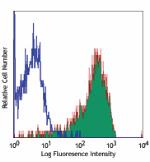- Clone
- HLy-9.1.25 (See other available formats)
- Regulatory Status
- RUO
- Other Names
- Ly9, Ly-9, SLAMF3
- Isotype
- Mouse IgG1, κ
| Cat # | Size | Price | Quantity Check Availability | ||
|---|---|---|---|---|---|
| 326109 | 100 µg | $270.00 | |||
| 326110 | 1 mg | $677.00 | |||
Select size of product is eligible for a 40% discount! Promotion valid until December 31, 2024. Exclusions apply. To view full promotion terms and conditions or to contact your local BioLegend representative to receive a quote, visit our webpage.
CD229 is a 100-120 kD glycoprotein. It is a member of the SLAM family, a CD2 subset of the Ig superfamily, known as Ly9 or SLAMF3. CD229 is expressed on T cells, B cells, NK cells, and thymocytes. It functions as a homophilic adhesion molecule through binding to CD229 itself. The cytoplasmic tail of CD229 binds to SAP and Grb2 proteins. CD229 is involved in enhancing T cell activation and Th2 polarization. HLy9.1.25 antibody recognizes epitope A in the first Ig domain of Ly9 molecule.
Product Details
- Verified Reactivity
- Human
- Antibody Type
- Monoclonal
- Host Species
- Mouse
- Immunogen
- 300.19 cell line transfected with the CD229 full-length DNA
- Formulation
- 0.2 µm filtered in phosphate-buffered solution, pH 7.2, containing no preservative.
- Preparation
- The Ultra-LEAF™ (Low Endotoxin, Azide-Free) antibody was purified by affinity chromatography.
- Concentration
- The antibody is bottled at the concentration indicated on the vial, typically between 2 mg/mL and 3 mg/mL. Older lots may have also been bottled at 1 mg/mL. To obtain lot-specific concentration and expiration, please enter the lot number in our Certificate of Analysis online tool.
- Storage & Handling
- The antibody solution should be stored undiluted between 2°C and 8°C. This Ultra-LEAF™ solution contains no preservative; handle under aseptic conditions.
- Application
-
FC - Quality tested
IP, ICC, FA - Reported in the literature, not verified in house - Recommended Usage
-
Each lot of this antibody is quality control tested by immunofluorescent staining with flow cytometric analysis. For flow cytometric staining, the suggested use of this reagent is ≤ 2.0 µg per million cells in 100 µL volume. It is recommended that the reagent be titrated for optimal performance for each application.
- Application Notes
-
Additional reported (for the relevant formats) applications include: immunoprecipitation1,2, and immunocytochemistry3. The Ultra-LEAF™ Purified antibody (Endotoxin < 0.01 EU/µg, Azide-Free, 0.2 µm filtered) is recommended for functional assays (Cat. Nos. 326109 & 326110).
-
Application References
(PubMed link indicates BioLegend citation) -
- de la Fuente MA, et al. 2001. Blood 97:3513.
- Martin M, et al. 2005. J. Immunol. 174:5977.
- Romero X, et al. 2005. J. Immunol. 174:7033.
- RRID
-
AB_2832637 (BioLegend Cat. No. 326109)
AB_2832637 (BioLegend Cat. No. 326110)
Antigen Details
- Structure
- 100-120 kD glycoprotein, SLAM family, CD2 subset of Ig superfamily
- Distribution
-
T cells, B cells, NK cells, thymocytes
- Function
- Homophilic adhesion, T cell activation, Th2 cell polarization
- Ligand/Receptor
- CD229
- Cell Type
- B cells, NK cells, T cells, Thymocytes
- Biology Area
- Immunology
- Molecular Family
- Adhesion Molecules, CD Molecules
- Antigen References
-
1. Sandrin MS, et al. 1996. Immunogenetics 43:13.
2. de la Fuente MA, et al. 2001. Blood 97:3513.
3. Romero X, et al. 2005. J. Immunol. 174:7033. - Gene ID
- 4063 View all products for this Gene ID
- UniProt
- View information about CD229 on UniProt.org
Other Formats
View All CD229 Reagents Request Custom Conjugation| Description | Clone | Applications |
|---|---|---|
| PE anti-human CD229 (Ly-9) | HLy-9.1.25 | FC |
| Ultra-LEAF™ Purified anti-human CD229 (Ly-9) | HLy-9.1.25 | FC,IP,ICC,FA |
| TotalSeq™-B1026 anti-human CD229 (Ly-9) | HLy-9.1.25 | PG |
| TotalSeq™-C1026 anti-human CD229 (Ly-9) | HLy-9.1.25 | PG |
Compare Data Across All Formats
This data display is provided for general comparisons between formats.
Your actual data may vary due to variations in samples, target cells, instruments and their settings, staining conditions, and other factors.
If you need assistance with selecting the best format contact our expert technical support team.
-
PE anti-human CD229 (Ly-9)

Human peripheral blood lymphocytes stained with HLy-9.1.25 P... -
Ultra-LEAF™ Purified anti-human CD229 (Ly-9)
-
TotalSeq™-B1026 anti-human CD229 (Ly-9)
-
TotalSeq™-C1026 anti-human CD229 (Ly-9)
